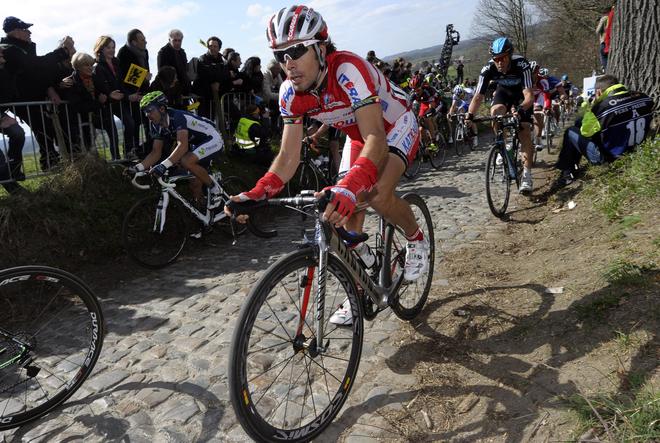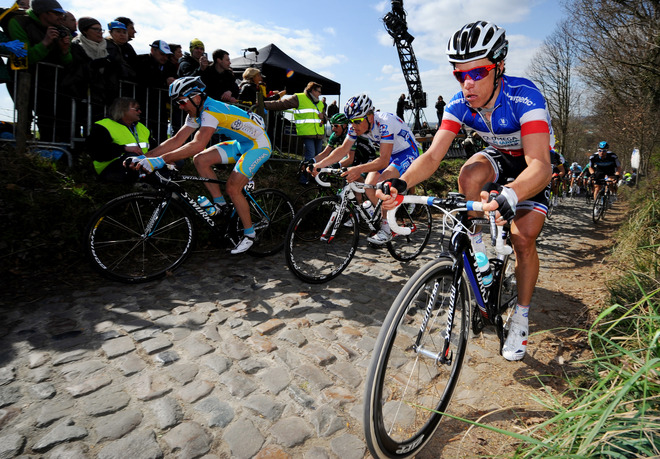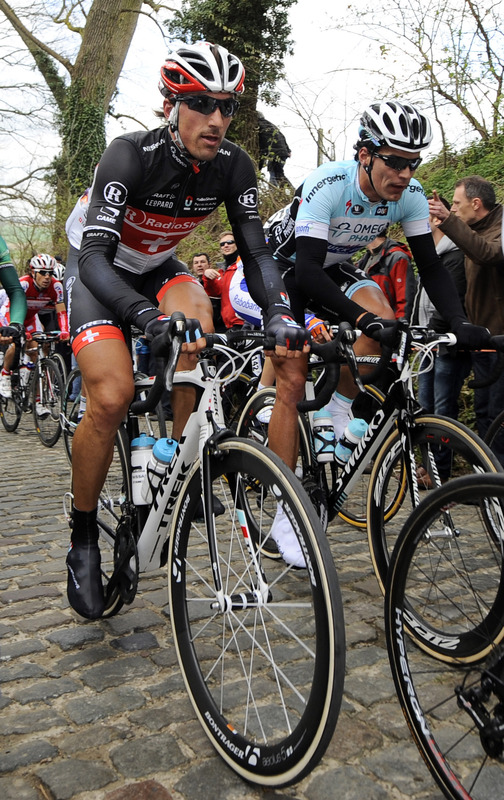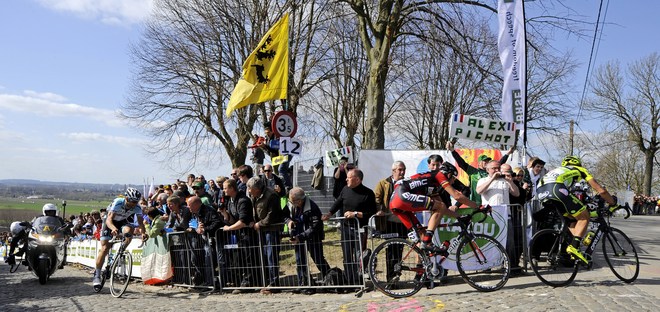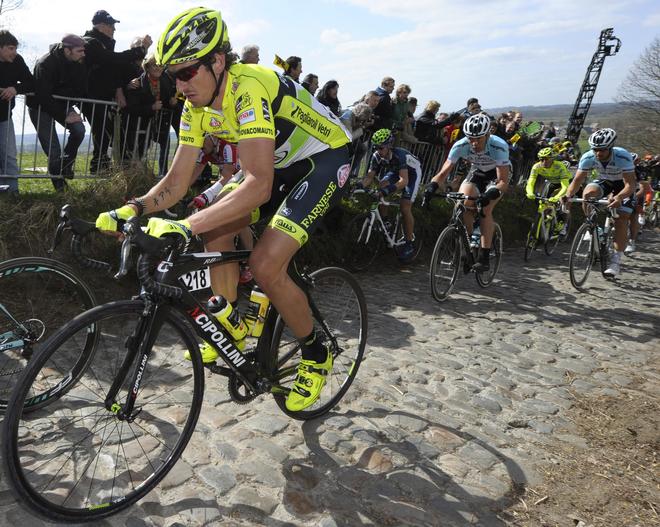
الأحد، 1 أبريل 2012
UCI must pay Keisse 100,000 Euros, Belgian court rules
 .
.A Belgian court has ordered the UCI to pay Iljo Keisse 100,000 euros for unjustly prohibiting him from racing. It is only the latest step in a long and complicated legal case for Keisse, now with Omega Pharma-Quick Step.
Keisse tested positive at the Six Days of Gent in November 2008, and the Belgian federation banned him for two years. The federation lifted that ban end of 2009 and he resumed racing. The UCI appealed that decision, and the CAS overturned it, confirming that Keisse was to ride his sit out his entire ban. He was allowed to ride in all areas other than Belgium as of August 2011, but was only allowed to ride in Belgium against as of January 27, 2012.
The Belgian court has now ruled that the UCI unfairly prohibited Kesse from riding from December 2010 and May 2011. He will also be allowed to retain the second place finish in the Rotterdam Six Day race from January 2011.
So near but so far for Pozzato at Tour of Flanders
Just 300 metres in length, the final helling of the Ronde kicks up to
a ferocious 20 percent gradient near its summit, and it was here that
Pozzato's forcing looked to have put Boonen into significant difficulty.
To the horror of the Flemish faithful gathered on the hillside, the
Italian pair of Pozzato and Alessandro Ballan (BMC) opened a small gap over a Boonen, who was clearly struggling to keep his gear turning over.
The Belgian fought gamely to limit his losses, however, and stayed just about within reaching distance of Ballan's back wheel as the road levelled out again. Speaking to Cyclingnews afterwards, Farnese Vini-Selle Italia manager Luca Scinto lamented that the road hadn't gone upwards just that little bit further.
"It's a pity that the Paterberg wasn't 20 metres longer," Scinto said, shaking his head. "I think Boonen was on the limit. With that extra 20 metres, Pippo would have been able to drop Boonen, and the race might have had a very different finale."
Amid the tumult of the natural amphitheatre of the Paterberg, which the race crossed three times, Pozzato did not appear to be fully aware of how close he had come to shedding Boonen from the winning break. "I went to the front on a couple of climbs in the finale, and to tell the truth, I had the impression that Boonen was a little bit in difficulty, but there was nothing to do," Pozzato said as he waited to mount the podium.
Fabian Cancellara was forced to abandon the race after he crashed with 60 kilometres to go, and Pozzato explained that the Swiss rider's absence in the finale contributed to his decision to seize the initiative on the Paterberg. "Fabian's crash changed the course of the race," Pozzato said. "Without him, we had to take the I head on That's why I went to the front on a couple of climbs in the finale."
Once over the top, and with just 20 seconds in hand over the chasing Peter Sagan (Liquigas-Cannondale), the leaders quickly put their swords back in their scabbards and became allies of circumstance to ensure that the Slovak didn't get back on. As the kilometres counted down towards Oudenaarde and it became clear that it was a three-man race, however, Pozzato reached a more explicit agreement with his friend and sometime training partner Ballan in a bid to stack the cards in their favour.
"Ale and I tried to wear out Boonen. I said that if he attacked, I wouldn't go and follow him, and that's the way it was, but Boonen was the still the strongest," Pozzato said.
Each time Ballan jumped, Boonen was promptly on his wheel to snuff out the danger, but with each effort, a little more of the venom was being drawn from the Belgian's sprint. With that in mind, Pozzato opted to play his hand in the finishing straight rather than attempt a surprise move himself, but the cagey nature of the final kilometre ultimately played against him.
"I tried to win, I did everything that I could, but unfortunately I struggled with the kind of sprint that it was in the end. It was from an almost standing start and Tom showed that he was the most explosive," said Pozzato.
Pozzato still had all of Flanders on tenterhooks in the final metres of the race, as he threatened to come around Boonen and take a famous victory. An eerie hush fell over Oudenaarde as the leaders approached the line, and the raucous roar that broke the silence confirmed that the home team had won.
"In the sprint, I took his wheel and then I tried to go past him but he didn't even lose a centimetre. Congratulations to him, he deserved to win," said Pozzato, who now turns his attentions to Paris-Roubaix. "We're going on to Roubaix very motivated, which is a different race and one where I can do well."
The Belgian fought gamely to limit his losses, however, and stayed just about within reaching distance of Ballan's back wheel as the road levelled out again. Speaking to Cyclingnews afterwards, Farnese Vini-Selle Italia manager Luca Scinto lamented that the road hadn't gone upwards just that little bit further.
"It's a pity that the Paterberg wasn't 20 metres longer," Scinto said, shaking his head. "I think Boonen was on the limit. With that extra 20 metres, Pippo would have been able to drop Boonen, and the race might have had a very different finale."
Amid the tumult of the natural amphitheatre of the Paterberg, which the race crossed three times, Pozzato did not appear to be fully aware of how close he had come to shedding Boonen from the winning break. "I went to the front on a couple of climbs in the finale, and to tell the truth, I had the impression that Boonen was a little bit in difficulty, but there was nothing to do," Pozzato said as he waited to mount the podium.
Fabian Cancellara was forced to abandon the race after he crashed with 60 kilometres to go, and Pozzato explained that the Swiss rider's absence in the finale contributed to his decision to seize the initiative on the Paterberg. "Fabian's crash changed the course of the race," Pozzato said. "Without him, we had to take the I head on That's why I went to the front on a couple of climbs in the finale."
Once over the top, and with just 20 seconds in hand over the chasing Peter Sagan (Liquigas-Cannondale), the leaders quickly put their swords back in their scabbards and became allies of circumstance to ensure that the Slovak didn't get back on. As the kilometres counted down towards Oudenaarde and it became clear that it was a three-man race, however, Pozzato reached a more explicit agreement with his friend and sometime training partner Ballan in a bid to stack the cards in their favour.
"Ale and I tried to wear out Boonen. I said that if he attacked, I wouldn't go and follow him, and that's the way it was, but Boonen was the still the strongest," Pozzato said.
Each time Ballan jumped, Boonen was promptly on his wheel to snuff out the danger, but with each effort, a little more of the venom was being drawn from the Belgian's sprint. With that in mind, Pozzato opted to play his hand in the finishing straight rather than attempt a surprise move himself, but the cagey nature of the final kilometre ultimately played against him.
"I tried to win, I did everything that I could, but unfortunately I struggled with the kind of sprint that it was in the end. It was from an almost standing start and Tom showed that he was the most explosive," said Pozzato.
Pozzato still had all of Flanders on tenterhooks in the final metres of the race, as he threatened to come around Boonen and take a famous victory. An eerie hush fell over Oudenaarde as the leaders approached the line, and the raucous roar that broke the silence confirmed that the home team had won.
"In the sprint, I took his wheel and then I tried to go past him but he didn't even lose a centimetre. Congratulations to him, he deserved to win," said Pozzato, who now turns his attentions to Paris-Roubaix. "We're going on to Roubaix very motivated, which is a different race and one where I can do well."
Cummings to return at Pais Vasco
 .
.BMC rider Steven Cummings will make his return to competitive action on Monday at Paris Vasco. The British rider has been sidelined since he was brought down in stage three of the Volta ao Algarve on February 17, a crash that resulted in a broken pelvis.
The Volta ao Algarve had previously been a happy hunting ground for the 31-year-old from the Wirral, Merseyside, who came second in last season's Tour of Britain in the colours of Team Sky. In 2011 he led for much of the race in Portugal, up until the final time trial, and finished in seventh place overall. This year's edition was memorable for all the wrong reasons though.
Now Cummings is ready to return to the road at Pais Vasco, which is known to English speaking cycling fans as the Tour of the Basque Country. The six-stage race is one of the oldest on the calendar, dating back to 1924, and received the go-ahead recently after concerns about the faltering Spanish economy. It is known for its tough mountain stages.
"I think I'm at a level now where I can survive the race and do work for the team," Cummings said. "I was off the bike for three weeks and then the first week or so was very painful because the fracture was where I sat on the saddle."
Low-key build-up to Tour of Flanders for Team Sky
Flecha was in fine form in February, finishing third at the Tour of Qatar and the Omloop Het Nieuwsblad, but a broken hand sustained in training has kept him away from competitive action since. He makes his return on Sunday, and he admitted that he did not know what kind of performance he would be able to deliver in a race where he finished on the podium in 2008.
“I just want to do the best I can,” Flecha said on Friday evening. “Of course I haven’t been racing for a while but there’s nothing more that I can do to try to be 100% for Sunday. That’s the only thing that I expect from myself.”
A small pocket of journalists attended a rather sombre Sky press conference in Kortrijk, where Flecha was reticent to give anything away about the set-up of his team for De Ronde. “The tactics will be whatever the plan is,” he said. “I can’t tell you yet, because we haven’t done any team meeting yet, but whatever the DS asks me I will do.”
Flecha was a little more expansive when asked about how much the team would miss Geraint Thomas in Flanders. The Welshman was one of the revelations of last year’s cobbled campaign, but he has opted to focus his attentions on the track world championships this spring, as he builds towards the London 2012 Olympics.
“He’s a great rider and he showed already last year that he can do really good on these races,” Flecha said. “Of course we miss him, but the Olympics is one time every four years. Having the Olympics in your own country is something unique. The classics are every year, so he can do really well here many times.”
One young rider who is on the Sky team for Flanders is the quietly-spoken Edvald Boasson Hagen. The multi-talented Norwegian took 5th place in the sprint at Gent-Wevelgem last Sunday, but he has yet to make a significant impact at De Ronde. “I’m not really struggling with any pressure. I just put on my own pressure. There’s always some expectation from the press, but I don’t think a lot about that,” he said.
Boasson Hagen was typically concise when assessing the new route of the Tour of Flanders, which sees the Muur and Bosberg finale removed in favour of three ascensions of the Kwaremont and Paterbeg. “It’s really hard and up and down and the new climbs are going to make changes. It’s the same for everyone,” he said. “We all have to do it and get over the climbs. The Kwaremont and Paterberg is the main patch where it’s going to be really hard.”
For his part, directeur sportif Steven De Jongh anticipated that the selection would be gradual one as the difficulty of the new circuit takes its toll, particularly if weather conditions turn inclement. “There won’t be big groups in the finale, because it’s all hard from there. It’s going to be an elimination race I think, especially when they forecast rain even if maybe in the afternoon it’s going to be dry.”
And Sky’s hopes? “For all the teams, they’re going into the unknown but that also gives some chances. If it’s hard I’m sure you will have strong riders in the finale, but if our guys are good and are with that select group over those climbs, it will be easier for them to get in a good position for the other climbs
Crucial weekend for Britain's Olympic hopefuls
 .
.With four spots up for grabs on the Team GB squad for the women's road race at the London 2012 Olympics this summer, tomorrow's Women's Tour of Flanders is set to provide a host of clues as to which women are making the early running to for selection. Five of the six riders who are looking to make the grade for the summer will be on the start line: AA Drink–leontien.nl teammates Lizzie Armitstead, Emma Pooley, Lucy Martin and Sharon Laws; and Faren Honda's Nicole Cooke.
Armitstead has enjoyed a successful start to the season by claiming victories at Omloop van het Hageland and Gent-Wevelgem and has described tomorrow's race as her main early season target. Relations between her and Cooke had not been the most cordial since their spat in the wake of Team GB's below-par showing at the 2011 road world championships in Copenhagen, but the women buried the hatchet at a training camp last month.
National coach Chris Newton is confident that the focus will be on the road this weekend and that although there is still months of work to be done ahead of the summer, tomorrow's race is important as a fact-finding exercise.
“The riders are coming through from their winter training and early season prep and going into the racing season," Newton said. "We won’t have everyone on song straight away which is understandable. To be fair what we want is everyone to be on song come July and it will be a bit of a wave pattern – some riders going better than others at certain times but it will eventually become a peak for July.
“I’m out there at Tour of Flanders this weekend to oversee the race and get a bit more insight to them and to see how things are going - technically, tactically, on form, see how races are going and how riders are contributing to that – whether they are forcing it, reacting to it.”
Cavendish to start charitable scholarship scheme
 .
.Great Britain's reigning world road race champion Mark Cavendish (Team Sky) used Thursday night's Isle of Man Sportsperson of the Year Awards to announce that he will be funding a new scholarship scheme to help the development of some of the island's brightest sporting prospects. Cavendish hails from the island off England's north west coast and he revealed that his own struggles were a motivating factor in his decision to start up the scheme, which will provide annual assistance for three youngsters.
"This island is great at producing sportspeople across all sports and the youngsters deserve the opportunity to get away and show it off," he said, after collecting his award for Sportsman of the Year for the eighth consecutive year.
"I love this island and I really love coming back here, but I know first-hand how difficult it can be to get off it every weekend - both financially and practically. I thought 'now I'm in a position to help people who are in the same position that I was in.'"
"Part of Mark's donation will be used each year to ensure we can send riders to British Cycling's regional school of racing and they will go as members of Cavendish Racing Isle of Man," said Geoff Karran, the island's chairman for sport. "This is a fantastic bequest and gives a fantastic opportunity to young cyclists
Bartoli regrets Muur absence
 .
.Michele Bartoli has voiced his disappointment at the absence of the Muur van Geraardsbergen from the route of this year’s edition of the Tour of Flanders. The Italian has found memories of the Muur, after soloing clear on its slopes to win De Ronde in 1996, but the legendary helling has been removed from the course as the race now finishes in Oudenaarde rather than in Meerbeke.
“It’s worse than taking the Poggio from Milan-San Remo,” Bartoli told Gazzetta dello Sport. “For me, the Muur is a piece of the history of the Tour of Flanders, it’s a huge loss. I mean, if I had attacked at another place [in 1996], it wouldn’t be remembered so readily now.”
While the Muur and the Bosberg have consigned to the history books, the finale of the race now features three ascensions of the Oude Kwaremont and the Paterberg. On paper, the new route is more difficult, but Bartoli pointed out that it would all depend on the approach of the riders.
“The Oude Kwaremont isn’t very hard, but it’s long and disjointed. It’s also a bit anomalous in that there’s a stretch of flat pavé afterwards that can hurt. The Paterberg is short but it goes up at 20%, a real wall,” he said. “I couldn’t say if Flanders will be harder because it depends on the riders, but at its key points, the roads are very narrow, and technical ability will be fundamental.”
Bartoli reckons positioning ahead of the first ascension of the Kwaremont with 70km to go could prove essential, but he was loathe to pick a favourite out of Tom Boonen or Fabian Cancellara. “It’s hard for Boonen to drop Cancellara, but the opposite could happen. Although if it doesn’t, then Tom would be at a real advantage in the sprint
US 24-hour mountain bike nationals awarded to Gallup
 .
.USA Cycling have awarded the 2013 and 2014 24-Hour Mountain Bike National Championships to Gallup, New Mexico. The event will be held on the third Sunday in June in each year in the Zuni Mountains in conjunction with the established 24 Hours in the Enchanted Forest race.
The 16-mile course is nearly entirely singletrack. It starts at 7,850 feet of elevation and reaches as high as 8,350 feet of elevation, featuring 1,344 feet of climbing.
"There are a lot of great endurance races and experienced race directors out there," Director of Zia Rides Lindsay Mapes said. "I've been thinking about nationals for a few years. We thought we had a shot - New Mexico has never hosted this event, Gallup is poised as a mountain bike destination, our team of organizers is seasoned, and we have a solid course. We're honored to have been selected and stoked about hosting in 2013-14!"
The two-year agreement between USA Cycling, the sport's national governing body, and Zia Rides is expected to bring approximately 300 of the country's best endurance mountain bike riders to New Mexico.
"We're looking forward to bringing the 2013 and 2014 USA Cycling Mountain Bike 24-Hour National Championships to Gallup," National Events Director Kelli Lusk said. "The course in the Zuni Mountains featuring so much singletrack and climbing will certainly challenge the best endurance riders in the country."
USA Cycling has already identified other locations for its 2013 and 2014 national championships. Cross country nationals will be held in the Lehigh Valley, Pennsylvania. Marathon nationals will be in Sun Valley, Idaho, and gravity nationals will be at Angel Fire Resort in New Mexico.
Sick Vos pulls out of Women's Tour of Flanders
 .
.Pre-race favourite Marianne Vos will not be present on the start line at tomorrow's Women's Tour of Flanders after falling ill, her Rabobank team hasconfirmed. Vos will be replaced in her team's ranks by Germany's Sarah Duster, and the 2008 Olympic gold medallist faces a race against time to be fit for the Energiewacht Tour, which starts on Wednesday. Earlier in the year she celebrated an incredible fourth consecutive cyclo-cross world championship and had made a pleasing start to the road season by winning the Ronde van Drenthe and the Trofeo Alfredo Binda.
“It’s really unfortunate for Marianne,” said Rabobank sporting director Jeroen Blijlevens. “The Tour of Flanders was one of her biggest targets of the spring. We hope that she is fit again soon.”
Blijlevens can take comfort in the fact that in spite of the absence of Vos his team are still blessed with lots of talent at their disposal for tomorrow's race, including France's rising star Pauline Ferrand Prevot and Annemiek van Vleuten and Tatiana Antoshina - who finished first and second at Flanders last year. They are set for an intriguing battle on the cobbles tomorrow with AA Drink–leontien.nl, whose lineup includes the in-form Lizzie Armitstead.
Hughes becomes Canadian National Development Coach

The Canadian Cycling Association (CCA) hired Ian Hughes as its Mountain Bike National Development Coach. From now on, the former Quebec Team Head Mountain Bike Coach will work within the National Team programs.
Hughes will be tasked to develop a national strategy aiming at facilitating the athletes' arrival on the international scene. This facilitating process will notably be through training camps and competition projects. In addition, Hughes will also have to elaborate talent detection tools, as well as contribute to the expansion of the mountain bike athletes' pool.
In his new functions, Hughes will work with provincial cycling associations, and in particular with regards to the implantation of the Long Term Athlete Development model (LTAD). In addition, he will pursue his implication in the National Coaching Certification Program (NCCP) and closely collaborate with all provincial and personal coaches. Finally, he will assist the National Team Head Mountain Bike Coach in order to establish fluid transitions between Development and High Performance programs.
"We are very happy to have Ian among us. We are also grateful to the Quebec Cycling Federation (FQSC) for having allowed us to use Ian's services as Mountain Bike National Development Coach. Because of his experience in mountain bike, his teaching approach and his training methodology, Ian is a great addition to our National Coaches team," said Jacques Landry, High Performance Director and Head Coach at the Canadian Cycling Association.
"I am extremely happy about the challenges this new job will provide. It was an opportunity I had to seize," said Hughes.
Evans and George fight back for Cape Epic stage win
With over 2000 metres of vertical ascent to conquer, George and Evans went on the attack at the base of the first major climb. Stander and Sauser initially left it up to the other teams to defend the minor podium places being threatened by Nedbank 360Life, but later Stander and Sauser decided to break clear themselves and pursue Evans and George.
“In order to win the stage and get back up to second on general classification, we knew we had to put on the pressure as early as possible. We have a lot of frustration built up from the last few days, but today we used it as our motivation. We had everything to gain,” said George. “The support of the crowds was incredible. We feel honoured to have such support.”
George and Evans experienced delays due to cut tyres on stages 1 and 5, losing significant time and the possibility of challenging Sauser and Stander for the overall win. On Saturday they charged straight through both water points on their way to victory.
“The first water point was quite early on at the top of the first big climb. We had a good rhythm and enough supplements in our bottles so decided to just keep going,” explained Evans. “I thought the second water point was 10km from the finish, so didn’t want to stop there. But it turns out it was about 20km from the finish! That was a hard, but rewarding effort today.”
Evans and George extended their lead in the African team competition, while Stander and Sauser still hold a substantial lead of 25 minutes and 57 seconds over Evans and George in the general classification, making Sunday’s short final stage virtually a victory procession
“In order to win the stage and get back up to second on general classification, we knew we had to put on the pressure as early as possible. We have a lot of frustration built up from the last few days, but today we used it as our motivation. We had everything to gain,” said George. “The support of the crowds was incredible. We feel honoured to have such support.”
George and Evans experienced delays due to cut tyres on stages 1 and 5, losing significant time and the possibility of challenging Sauser and Stander for the overall win. On Saturday they charged straight through both water points on their way to victory.
“The first water point was quite early on at the top of the first big climb. We had a good rhythm and enough supplements in our bottles so decided to just keep going,” explained Evans. “I thought the second water point was 10km from the finish, so didn’t want to stop there. But it turns out it was about 20km from the finish! That was a hard, but rewarding effort today.”
Evans and George extended their lead in the African team competition, while Stander and Sauser still hold a substantial lead of 25 minutes and 57 seconds over Evans and George in the general classification, making Sunday’s short final stage virtually a victory procession
السبت، 31 مارس 2012
History Of Bicycle

Wooden draisine (around 1820), the first two-wheeler and as such the archetype of the bicycle
The Draisienne, Laufmaschine, or dandy horse was the first human means of transport to use only two wheels in tandem and was invented by the German Baron Karl von Drais. It is regarded as the forerunner of the modern bicycle and was introduced by Drais to the public in Mannheim in summer 1817 and in Paris in 1818.[10] Its rider sat astride a wooden frame supported by two in-line wheels and pushed the vehicle along with his/her feet while steering the front wheel.
Michaux' son on velocipede 1868
Thomas McCall in 1869 on his velocipede
The first mechanically-propelled 2-wheel vehicle may have been built by Kirkpatrick MacMillan, a Scottish blacksmith, in 1839, although the claim is open to dispute.[11] He is also associated with the first recorded instance of a cycling traffic offence, when a Glasgow newspaper reported in 1842 an accident in which an anonymous "gentleman from Dumfries-shire... bestride a velocipede... of ingenious design" knocked over a little girl in Glasgow and was fined five shillings.[12]
In the early 1860s, Frenchmen Pierre Michaux and Pierre Lallement took bicycle design in a new direction by adding a mechanical crank drive with pedals on an enlarged front wheel (the velocipede). Another French inventor by the name of Douglas Grasso had a failed prototype of Pierre Lallement's bicycle several years earlier. Several inventions followed using rear wheel drive, the best known being the rod-driven velocipede by Scotsman Thomas McCall in 1869. The French creation, made of iron and wood, developed into the "penny-farthing" (historically known as an "ordinary bicycle", a retronym, since there was then no other kind).[13] It featured a tubular steel frame on which were mounted wire-spoked wheels with solid rubber tires. These bicycles were difficult to ride due to their very high seat and poor weight distribution. In 1868 a Michaux cycle was brought to Coventry, England by Rowley Turner, sales agent of the Coventry Sewing Machine Company (which soon became the Coventry Machinist Company). His uncle, Josiah Turner, together with business partner James Starley used this as a basis for the 'Coventry Model' in what became Britain's first cycle factory.[14]
A penny-farthing or ordinary bicycle photographed in the Škoda Auto museum in the Czech Republic
Bicycle in Plymouth, England at the start of the 20th century
The dwarf ordinary addressed some of these faults by reducing the front wheel diameter and setting the seat further back. This necessitated the addition of gearing, effected in a variety of ways, to efficiently use the power available. However, having to both pedal and steer via the front wheel remained a problem. J. K. Starley (nephew of James Starley), J. H. Lawson, and Shergold solved this problem by introducing the chain drive (originated by the unsuccessful "bicyclette" of Englishman Henry Lawson),[15] connecting the frame-mounted cranks to the rear wheel. These models were known as dwarf safeties, or safety bicycles, for their lower seat height and better weight distribution. (Although without pneumatic tires the ride of the smaller wheeled bicycle would be much rougher than that of the larger wheeled variety.) Starley's 1885 Rover, manufactured in Coventry, England,[16] is usually described as the first recognizably modern bicycle. Soon, the seat tube was added, creating the double-triangle diamond frame of the modern bike.
Further innovations increased comfort and ushered in a second bicycle craze, the 1890s' Golden Age of Bicycles. In 1888, Scotsman John Boyd Dunlop introduced the first practical pneumatic tire, which soon became universal. Soon after, the rear freewheel was developed, enabling the rider to coast. This refinement led to the 1890s invention[17] of coaster brakes. Derailleur gears and hand-operated cable-pull brakes were also developed during these years, but were only slowly adopted by casual riders. By the turn of the century, cycling clubs flourished on both sides of the Atlantic, and touring and racing became widely popular.
Bicycles and horse buggies were the two mainstays of private transportation just prior to the automobile, and the grading of smooth roads in the late 19th century was stimulated by the widespread advertising, production, and use of these devices
Omega Pharma-QuickStep with “110 options” for Tour of Flanders

The team has a stunning 23 wins so far this season, with five of them coming in the last ten days. Niki Terpstra opened the streak by winning Dwars Door Vlaanderen, followed by Tom Boonen's wins in the E3 Prijs Vlaanderen-Harelbeke and Gent-Wevelgem. Sylvain Chavanel topped things off by winning the closing time trial of the Three Days of De Panne-Koksijde to take the overall win.
Chavanel had not been feeling well earlier, which affected his performance n Paris-Nice and kept him out of Milan-San Remo. His health problems “are completely behind him,” Peeters said.
Boonen is going into Sunday's race as top favourite and team captain, but his teammates will also be very present. Peeters likes that. “I prefer a team that is strong in with.”
How might the race go, and what will the team plan? “There are 110 scenarios for Sunday. I have something in mind and Saturday night we will sit around the table. We obviously want as many riders in the finals as possible and want to make no mistakes.
"The course is also a factor. This is new for everyone," Peeters added. “"For now it is conjecture what the course will be like. Before, you knew: we take 50 (riders) to the Muur (van Geraardsbergen) and break it open. Now that can happen anywhere.
Chavanel continues Omega Pharma-QuickStep winning streak
the concluding time trial. In spite of the extraordinary haul of 21 victories secured by his teammates in the opening three months of the season, Chavanel was surprisingly still itching to get off the mark when he rolled down the start ramp in De Panne.
"It's always a relief when you bring wins to the team," Chavanel said in his post-race press conference. "I'm here to win races for the team and I've won two in one day, so I'm really happy. The team already had more than 20 wins and I was one of the riders who had yet to open his account."
After surgery to correct a herniated disc during the winter, Chavanel was concerted in his off-season efforts to regain his time trialling form. The fruits of his labour were apparent on Thursday, when he put four seconds into Lieuwe Westra (Vacansoleil-DCM) and a remarkable 17 into Svein Tuft (GreenEdge) on the 14.7km course to take the stage and the overall victory.
"It was my third time trial of the year. I was 4th in the time trial at San Luis and 6th at Paris-Nice, so I was so proud to win this one, especially as I was up against Westra, Tuft and Durbridge, guys who are good rouleurs."
The Tour of Flanders dominates Flemish thoughts as March turns to April, and in spite of Chavanel's protestations, there was more interest at the press conference in dissecting his Ronde chances than in discussing his first victory since the French national championships last June.
Chavanel's display on Thursday also saw him reel in Omega Pharma-QuickStep's 22nd and 23rd victories of the season. Their haul to date is just two shy of the team's entire tally for the past two years combined; a frankly astonishing turnaround after their travails last spring.
Given the performances of Boonen, Terpstra, Chavanel et al on the cobbles over the past week or so, there is a discernible sense of expectation about what Omega Pharma-QuickStep might achieve on Sunday. "There are a lot of riders who are in condition on the team, almost everybody," Chavanel acknowledged. "You can't escape the fact that we have a very strong team when you look at our recent results, but there are a lot of strong teams."
A lot of strong teams, but one particularly potent individual. Might the nature of Chavanel's victory have sounded a warning of sorts to Fabian Cancellara (RadioShack-Nissan)?
"I don't think he's afraid of anyone," Chavanel said.
While Cancellara and Boonen opted to forgo De Panne and rest up for Sunday, Chavanel was happy to keep racing through the week, reluctant to change a formula that came agonizingly close to paying off in full last April.
"Last year I came here and then I was second at the Tour of Flanders, so I didn't want to change my programme. I'm a rider who can take on efforts like this quite well, and in the past there have been riders who have ridden De Panne and then done very well on Sunday.
"This year it's a bit mitigated also as we had an exceptional De Panne because of the good weather, so it's been a little stressing but not enormously so."
After missing Milan-San Remo due to illness, Chavanel has recovered to play a starring role on the cobbles in the past week. He first marshalled Niki Terpstra to victory at Dwars Door Vlaanderen, and then aided Boonen at Harelbeke before helping himself to De Panne for good measure.
"I started the classics period at Waregem, I wasn't bad," Chavanel said, smiling at his understatement. "At Harelbeke too, I wasn't bad. And here at De Panne, I wasn't bad either.
الجمعة، 30 مارس 2012
Tom Boonen : I don't need to drop anyone in Tour of Flanders
You have to forget everything you've won before and try to race the best way you can," Boonen said. "It doesn't really matter how many races you have already won as it all depends on Sunday. We've got a good team which is ready to ride a good Ronde van Vlaanderen."
Although he won Paris-Roubaix in 2009, it's been a long six years since Boonen's last success in Belgium's most important race, De Ronde, and he underscored just how much victory means here to a native son.
"It's one of the two most important races of the season. I would really like to win," he said. "If you talk to the foreign guys they find it hard to understand why there’s that much attention, so much media coverage about one single race. It’s something that has been growing for the last hundred years. Every year it's a nice race."
Yet in the race's nearly 100 year history, no course has veered so drastically from the usual point-to-point, and three challenging circuits ending in Oudenaarde will change the tactics and the efforts for the riders, but Boonen said every year is different, and the key is to be flexible in your strategy.
"It can be a different style of racing every year on this course. If you have a strong guy or a strong team they will start racing pretty soon in the finale but it's also possible the good guys will be looking at each other in the finale and not much will change. It can happen on many spots, just like on the old course. It's a race where you have to be able to adapt and don't make too many plans in advance. Of course I know where the toughest spots are but that doesn't mean it'll happen there."
Boonen and every fan in Belgium knows that Radioshack-Nissan's Fabian Cancellara will be the rider that everyone is watching, but he said that it is hard to win the Tour of Flanders as a top favorite - something Cancellara found out the hard way in 2011.
"It doesn't really matter to me who's the favorite. [Cancellara] is a strong rider but I've never raced to beat someone specific except myself. Of course if he attacks in the finale and I see it's the decisive attack then I'll react but I'll certainly not mark every move he makes all day long."
This year, with the confidence of his bunch sprint win in Wevelgem on his side and the strength to tackle all the hellingen, Boonen knows he has an advantage that Cancellara does not have, as evidenced by Milan-San Remo: "He has to drop me because I've got the sprint as my weapon.
"Maybe he's got a slightly bigger engine but I'm a little bit faster. We're two different riders with the same objectives. If you look at it in a physical way then we're a level above the rest. with a really hard finale then we're the two riders who can decide the race although that doesn't want to say one of us will win. We've got the key to the race in our hands."
When asked about other rivals aside from Cancellara, the Belgian named his own teammate Sylvain Chavanel and Filippo Pozzato (Farnese Vinni – Selle Italia). "Pozzato is good, [Peter] Sagan is not bad. There's a lot of guys in good shape right now.
"Everybody has been talking about me and Fabian. It's not true that we're the only guys who're able to win. To me Sylvain is one of the favorites for the win because I've seen the course and know that a strong rider will win here, just like before. If Chavanel goes and Cancellara doesn't react? Then Sylvain is very lucky. We're good friends and it's no problem to me if someone else of the team wins on Sunday.
"Sagan? He can get pretty far maybe even this year. Sagan is going to be on the podium in the next three to four years. Edvald Boasson Hagen? If he's there in the sprint you have to pay attention to him but I don't count him in as one of the big favorites."
Logically it's hard to predict what is going to happen, but Boonen did offer an insight on possible scenarios. "My strongest point right now is that I don't have to be afraid of coming to the finish line with anyone," Boonen said. "I don't need to drop anyone. That's my main strength.
Although he won Paris-Roubaix in 2009, it's been a long six years since Boonen's last success in Belgium's most important race, De Ronde, and he underscored just how much victory means here to a native son.
"It's one of the two most important races of the season. I would really like to win," he said. "If you talk to the foreign guys they find it hard to understand why there’s that much attention, so much media coverage about one single race. It’s something that has been growing for the last hundred years. Every year it's a nice race."
Yet in the race's nearly 100 year history, no course has veered so drastically from the usual point-to-point, and three challenging circuits ending in Oudenaarde will change the tactics and the efforts for the riders, but Boonen said every year is different, and the key is to be flexible in your strategy.
"It can be a different style of racing every year on this course. If you have a strong guy or a strong team they will start racing pretty soon in the finale but it's also possible the good guys will be looking at each other in the finale and not much will change. It can happen on many spots, just like on the old course. It's a race where you have to be able to adapt and don't make too many plans in advance. Of course I know where the toughest spots are but that doesn't mean it'll happen there."
Boonen and every fan in Belgium knows that Radioshack-Nissan's Fabian Cancellara will be the rider that everyone is watching, but he said that it is hard to win the Tour of Flanders as a top favorite - something Cancellara found out the hard way in 2011.
"It doesn't really matter to me who's the favorite. [Cancellara] is a strong rider but I've never raced to beat someone specific except myself. Of course if he attacks in the finale and I see it's the decisive attack then I'll react but I'll certainly not mark every move he makes all day long."
This year, with the confidence of his bunch sprint win in Wevelgem on his side and the strength to tackle all the hellingen, Boonen knows he has an advantage that Cancellara does not have, as evidenced by Milan-San Remo: "He has to drop me because I've got the sprint as my weapon.
"Maybe he's got a slightly bigger engine but I'm a little bit faster. We're two different riders with the same objectives. If you look at it in a physical way then we're a level above the rest. with a really hard finale then we're the two riders who can decide the race although that doesn't want to say one of us will win. We've got the key to the race in our hands."
When asked about other rivals aside from Cancellara, the Belgian named his own teammate Sylvain Chavanel and Filippo Pozzato (Farnese Vinni – Selle Italia). "Pozzato is good, [Peter] Sagan is not bad. There's a lot of guys in good shape right now.
"Everybody has been talking about me and Fabian. It's not true that we're the only guys who're able to win. To me Sylvain is one of the favorites for the win because I've seen the course and know that a strong rider will win here, just like before. If Chavanel goes and Cancellara doesn't react? Then Sylvain is very lucky. We're good friends and it's no problem to me if someone else of the team wins on Sunday.
"Sagan? He can get pretty far maybe even this year. Sagan is going to be on the podium in the next three to four years. Edvald Boasson Hagen? If he's there in the sprint you have to pay attention to him but I don't count him in as one of the big favorites."
Logically it's hard to predict what is going to happen, but Boonen did offer an insight on possible scenarios. "My strongest point right now is that I don't have to be afraid of coming to the finish line with anyone," Boonen said. "I don't need to drop anyone. That's my main strength.
What is holding back a thriving bike culture in Arab
 .
.Despite a relatively recent increase in activity of nascent cycling advocacy groups in Egypt, there seems to be a set of factors affecting a more evident shift in Egyptian perception on urban cycling. Elaboration on each and every factor to be considered is surly beyond the purpose of this article, which is to shed some light on what can be deemed to be the most important of these factors:
- Energetic but inconsistent advocacy efforts: Online
social networking tools (most notably Facebook) made it amazingly easy
for cycling advocacy groups (among many others) to build a loyal
following, organize events and maintain communication. However, the
active core of these groups is extremely small, and thus the
sustainability of the activities and advocacy efforts of such groups
largely depends on the involvement of those persistent few. Spin-offs
must be encouraged, and advocacy efforts must begin to mature into more
active engagement of related groups (such as those of environmental
interests) and consistent activity.ent of those persistent few. Spin-offs must be encouraged, and
advocacy efforts must begin to mature into more active engagement of
related groups (such as those of environmental interests) and consistent
activity.

- Lack of formal, legal recognition for cycling: The New Egyptian Traffic Law does not include any provisions related to cyclists. The present Transportation Law, and Law 4/1994 for the Protection of the Environment make no mention of any planned incorporation of cycling as a mode of transport into the urban planning and environmental agenda. Promoting cycling as a healthy and low-carbon mode of transport is therefore in its very early stages in Egypt if not missing altogether.
- Lack of cycling equipment providers/vendors: At the time of this writing, the number of known
 cycling
equipment shops in Cairo (a city of 18 million residents) is about 5.
This does not include shops that provide repair/welding/construction of
cargo and utility bikes (which are used rather extensively in many areas
in Cairo). The (lack of) quality and availability of cycling equipment
is a main obstacle facing the latent interest in adoption of mass
utilitarian urban cycling in Cairo specifically and Egypt generally.
cycling
equipment shops in Cairo (a city of 18 million residents) is about 5.
This does not include shops that provide repair/welding/construction of
cargo and utility bikes (which are used rather extensively in many areas
in Cairo). The (lack of) quality and availability of cycling equipment
is a main obstacle facing the latent interest in adoption of mass
utilitarian urban cycling in Cairo specifically and Egypt generally.
- Pervasive social stigmas: Although female cyclists have evidently displayed active involvement in Egyptian cycling advocacy groups, the main impediment against a more enthusiastic adoption of urban cycling by female is conservative social stigmas, in addition to fear of harassment, which unfortunately plagues many densely populated areas in Cairo now.
San Francisco Spandex Racer Guy - with No Helmet
I end this web page collection of Amsterdam Bicycle Trends with
a picture of a bicycle you MIGHT actually see in San Francisco. Hidden in
thousands of other riders, the guy below is riding a 10 speed curved under
handlebar style bicycle, and wearing bicycle clothing (not dress clothes), and
his shoes clip to the peddles. He is not riding side saddle, and he does
NOT have a dynamo human powered headlight on this bicycle. No fenders on
the bicycle (very San Francisco), and there is no gigantic unbreakable security
chain to be seen. The only thing that gives him away as a true Amsterdam
bicyclist -> no bicycle helmet. Very interesting, there must be a
Amsterdam wide ban on bicycle helmets.
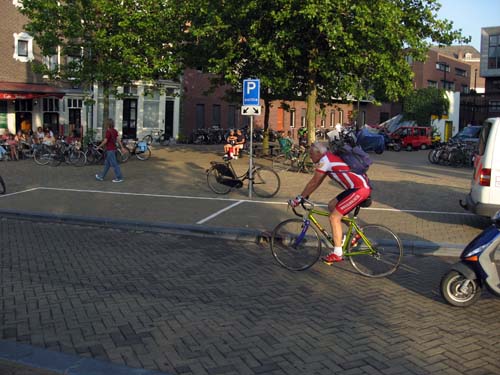
Small Wheels, Tall Seat Bicycles
There was one particular type of bicycle I'm not sure I
understood why it was so popular, but really stood out as a trend. These
bicycles have smaller wheels than a typical bicycle, and a taller seat to
compensate. Below is a picture of one of them to show you what I mean.
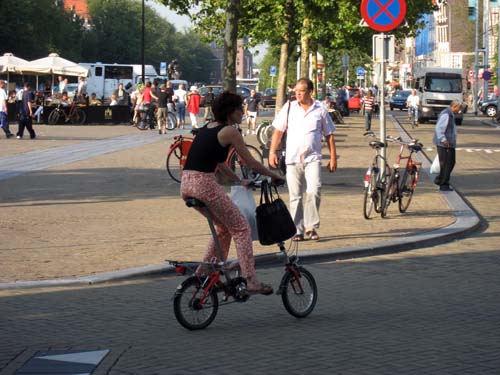
Another one a few minutes later.
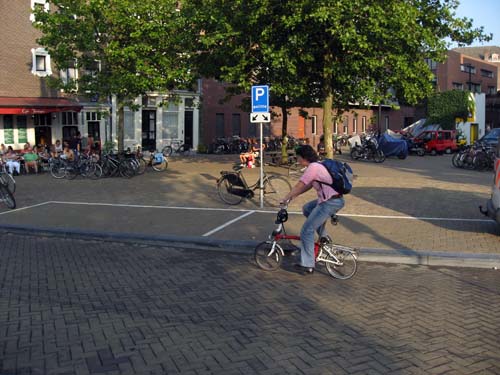
And another, you see what I mean? What are the advantages
of this design? Also notice there only seems to be one bar reaching from
the pedals/seat area forward to the handlebar and front wheel (instead of a
traditional triangle of at least two bars). That seems very specific to
all these bicycles, I wonder if it helps the bicycle fit somewhere or fold up
better?
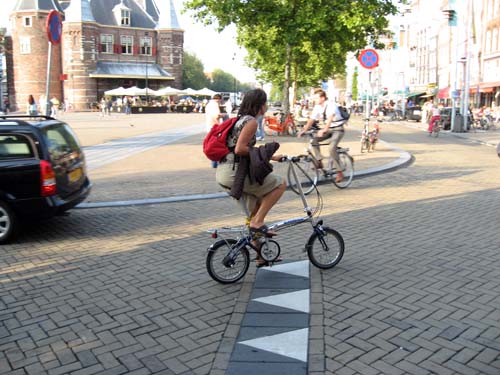
Another.
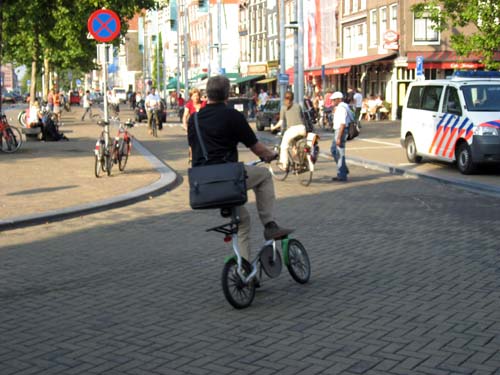
And another.

Another bicycle in Amsterdam with small wheels and a tall seat
to make up for it.
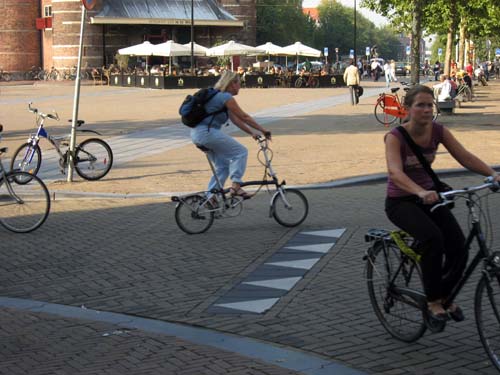
And another one.
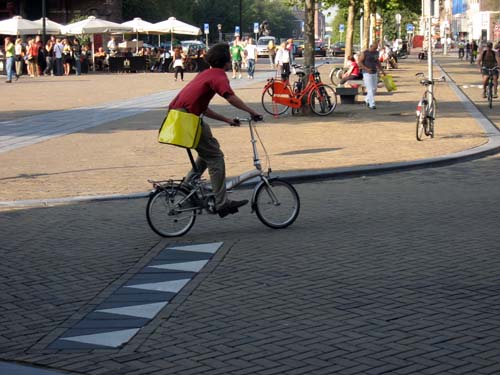
I'm not sure this really counts, but it was interesting so I'll
include it. In the picture below, the wheels aren't any smaller, but the
seat sure is taller, and I'm not sure I understand how this guy stops and puts
his feet down. He must have good visibility bicycling through Amsterdam.
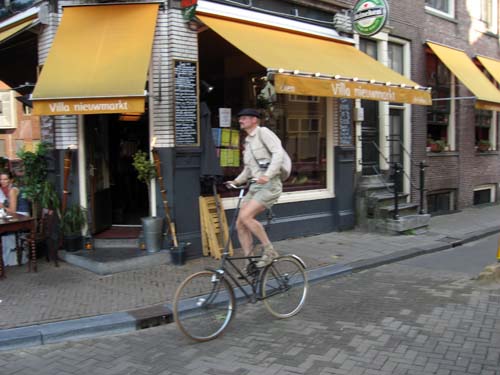
Another guy on a bicycle with small wheels and tall seat to make
up for the small wheels in Amsterdam.
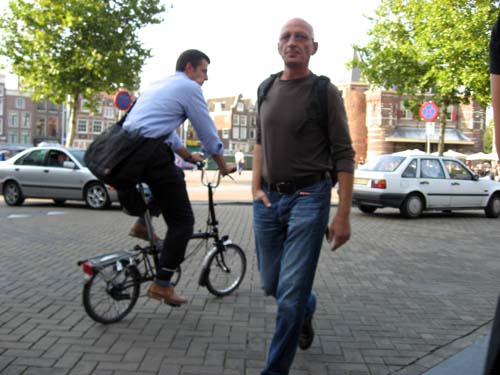
Cell Phone Use on Bicycles
One Amsterdam Bicycle Trend was that many MANY people liked to
chat on their cell phones as they zipped along the cobblestone streets on the
bicycles in Amsterdam. Below are some examples.
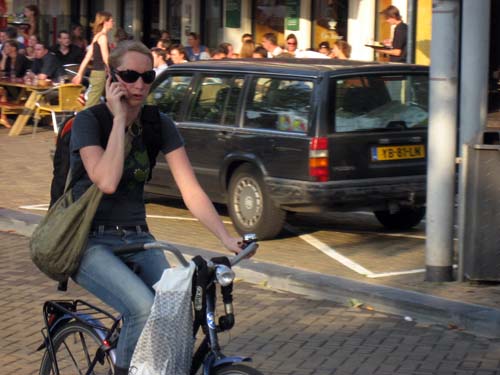
Woman in black talking on cell phone riding a bicycle in
Amsterdam.
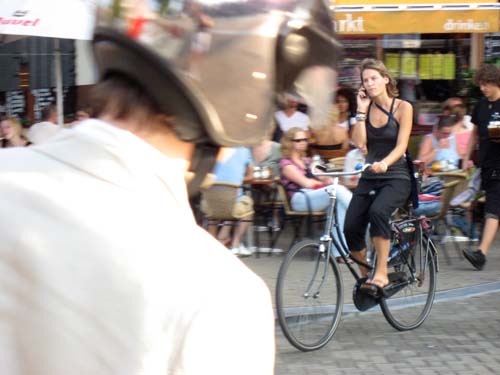
Lady with purse, white pants, on a pink bicycle talking on her
cell phone while riding a bicycle through Amsterdam.
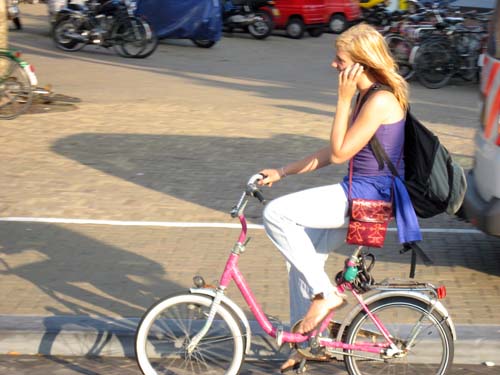
This woman has music headphones *AND* a cell phone while riding
her bicycle through Amsterdam.
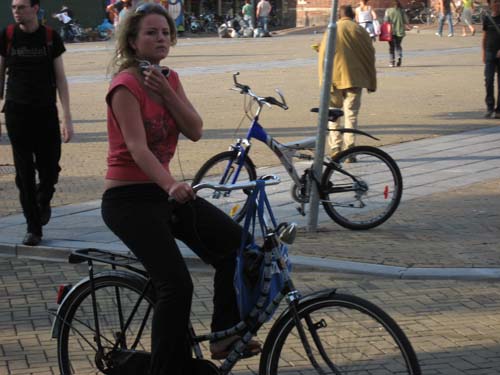
The woman pictured below is dressed well (high heels and all)
while riding her bicycle through Amsterdam, and is talking on her cell phone
while dodging pedestrians on her bicycle in Amsterdam.
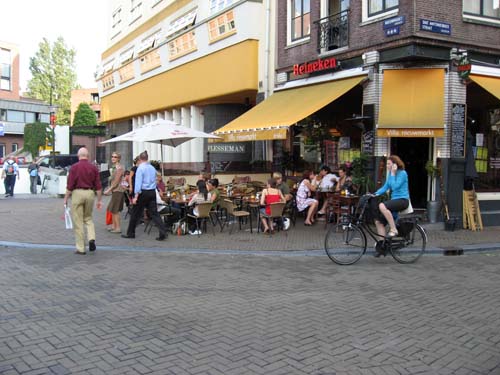
This guy swerved around this van while talking on his cell phone
and riding his bicycle in Amsterdam.

Another well dressed woman talking on her cell phone while
riding her bicycle through Amsterdam.
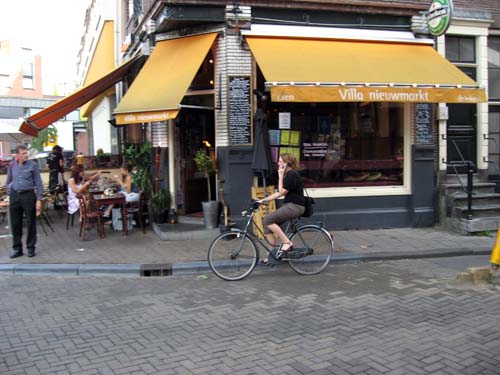
Amsterdam Bicycle Decorations
A common Amsterdam Bicycle Theme is coloring the entire bicycle
one color, or possibly a couple colors, but NEVER a good paint job, always
hacked together. The bicycle below is a good example as a solid red
bicycle. Notice the spray paint bled over the tires AND EVEN THE BICYCLE
CHAIN also, so the person who painted this didn't even take the wheels off, or
mask the tires, and the bicycle chain probably doesn't work quite right anymore.
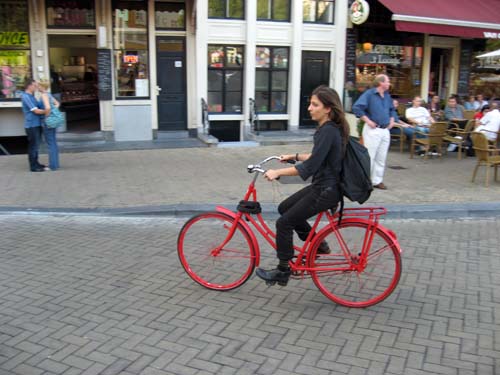
Below is the same sort of thing but the highest quality paint
job I saw in Amsterdam. The wheels are chrome, so are some of the bolts,
and there is some fine white detailing, so much care was taken to produce this
day glow orange Amsterdam beater bike.
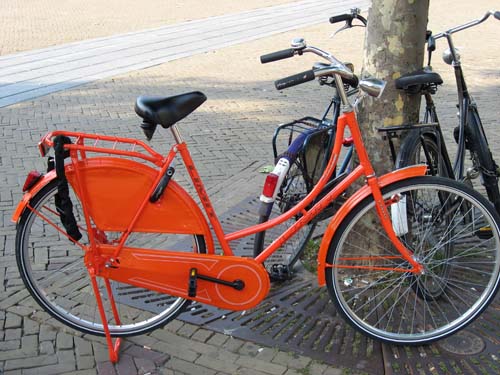
The bicycle below is decorated with flowers and streamers in
Amsterdam.
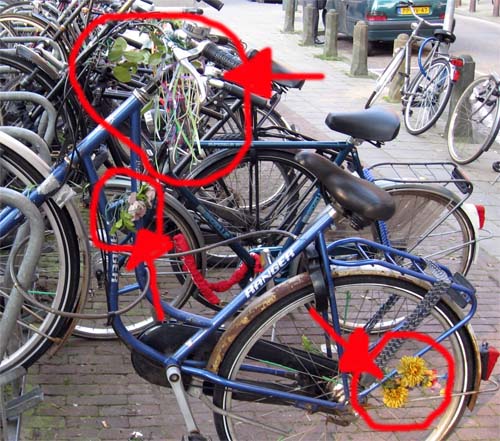
The paint job on the bicycle below was clearly done at the same
time, you can see both purple and blue on the rear wheel rim from spray paint
bleed over. And of course a massive Amsterdam bicycle chain securing the
bicycle from theft. Who would steal such a bike?
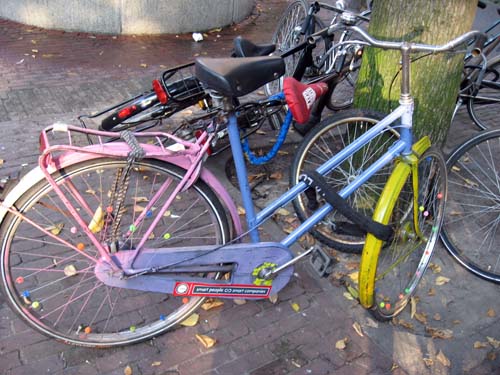
Industrial Work Buckets on the Front of Bicycles
One Amsterdam Bicycle Trend that would look pretty different in
downtown San Francisco is that many Amsterdam bicycles are outfitted with these
large, industrial looking work buckets mounted on the front of all shapes.
Below is a picture of one variation - bicycling through Amsterdam.
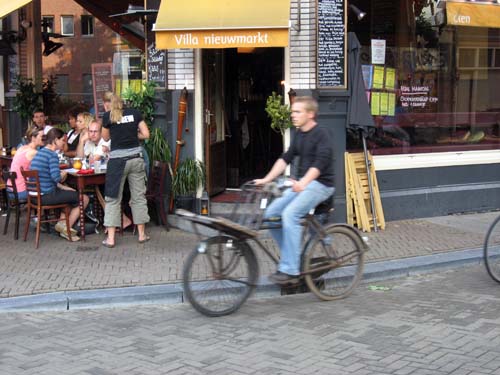
Below is another type of industrial work bucket front loader
thingy on the front of an Amsterdam bicycle. This one with a child mounted
in the suicide position on the bicycle.
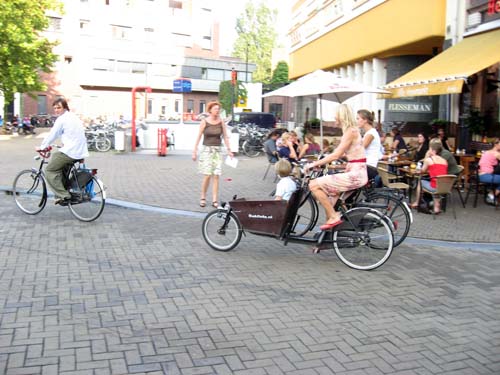
The picture below shows another custom work bucket mounted on a
bicycle in Amsterdam. This one has a blue tarp covering it.
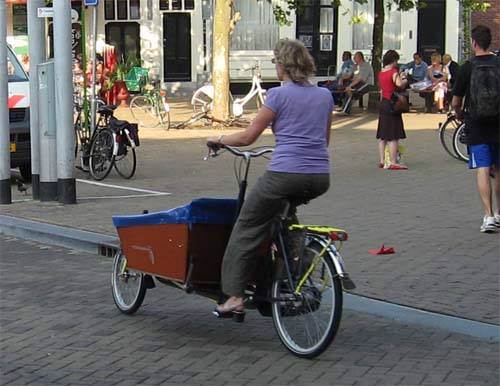
Here is another big box freight container on a bicycle.
This one required that the "bicycle" become a "tricycle", the locker on the
front of the bicycle is mounted between two bicycle wheels.
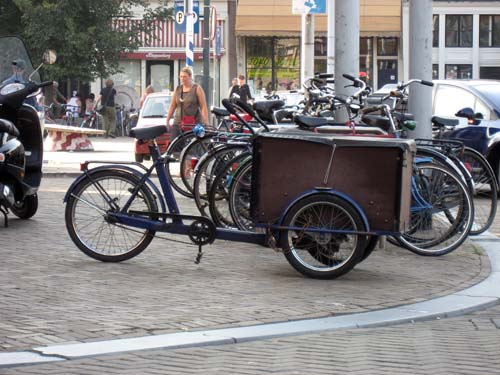
This is a good time to bring up a previous photo (this is the
only duplicate in this collection). In the picture below again is a great
example of multiple Amsterdam Bicycle Trends, including a large metal work
basket welded on the front of a bicycle.
Spectacular Gigantic Unbreakable Security Chains
The most beat-up, crappy, worthless bicycles in Amsterdam are
secured to bicycle racks with these INSANELY gigantic hardened steel security
chains and locks as big as the bicycle seat made of solid metal. Even if
theft is a big problem in Amsterdam, I think these chains are overkill. I
think you could cut the BICYCLE FRAME faster than cutting through one of these
heavy duty chains. For example, look at the two pictures below. The
second picture is a close up from the first picture.
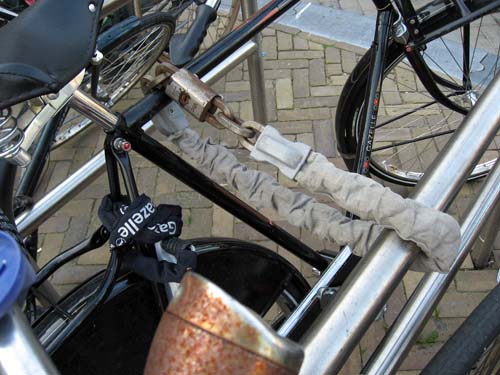
Check out this Amsterdam bicycle security chain and industrial
grade Amsterdam bicycle lock below. That chain looks like it could lift a
railroad boxcar full of lead weights without breaking! I have this image
in my mind of a bike thief with an acetylene cutting torch and welder's mask
sitting out in the open on the street in Amsterdam for 2 hours trying to cut
through one of these chains to steal a bicycle worth $15. :-)
Amsterdam bicycle thieves have to be starving to death in the face of such
industrial grade theft protection.
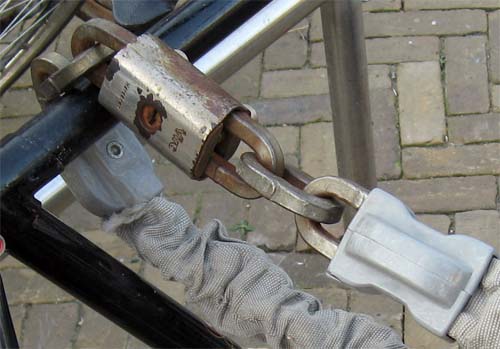
The guy who owns this bicycle is truly a security nut-case.
Look at the picture below, and tell me how two GIGANTIC REDUNDANT Amsterdam
chains and locks are helping security on this $15 bicycle? And my
goodness, could those padlocks be any more gigantic or secure or solid?
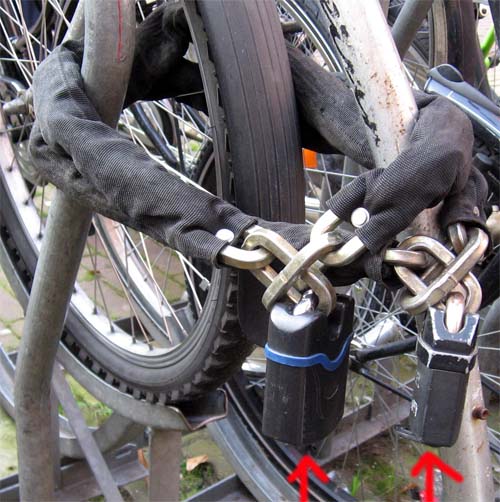
On the bicycle below seen sitting in a public place in
Amsterdam, you can see the large security chain locking the back wheel, and then
for added protection the circular sliding O-lock lock to *ALSO* lock the rear
wheel on this bicycle in Amsterdam. The O-lock circular sliding wheel
locks were also popular. I had one of these when I was 10 years old, but
my friends could easily walk away with my bicycle so I got a different lock.
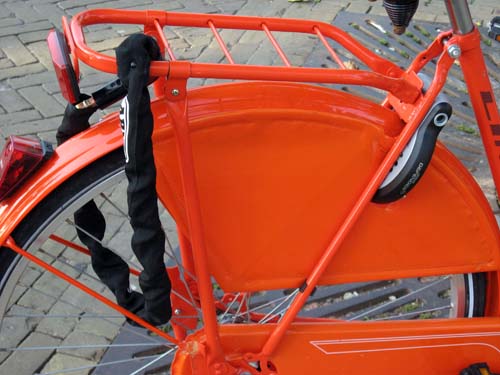
The picture below is of the same bicycle, just zoomed out to see
the whole bicycle. Now a note about the solid orange color -> I have two
theories why Amsterdam bicycles are painted such bright and unique aftermarket
colors: either 1) it is so their owners can find them when piled high in other
bicycles in Amsterdam bicycle racks, or 2) as a security measure, so that if
somebody steals their bicycle the thief would be worried it is too easily
recognizable.
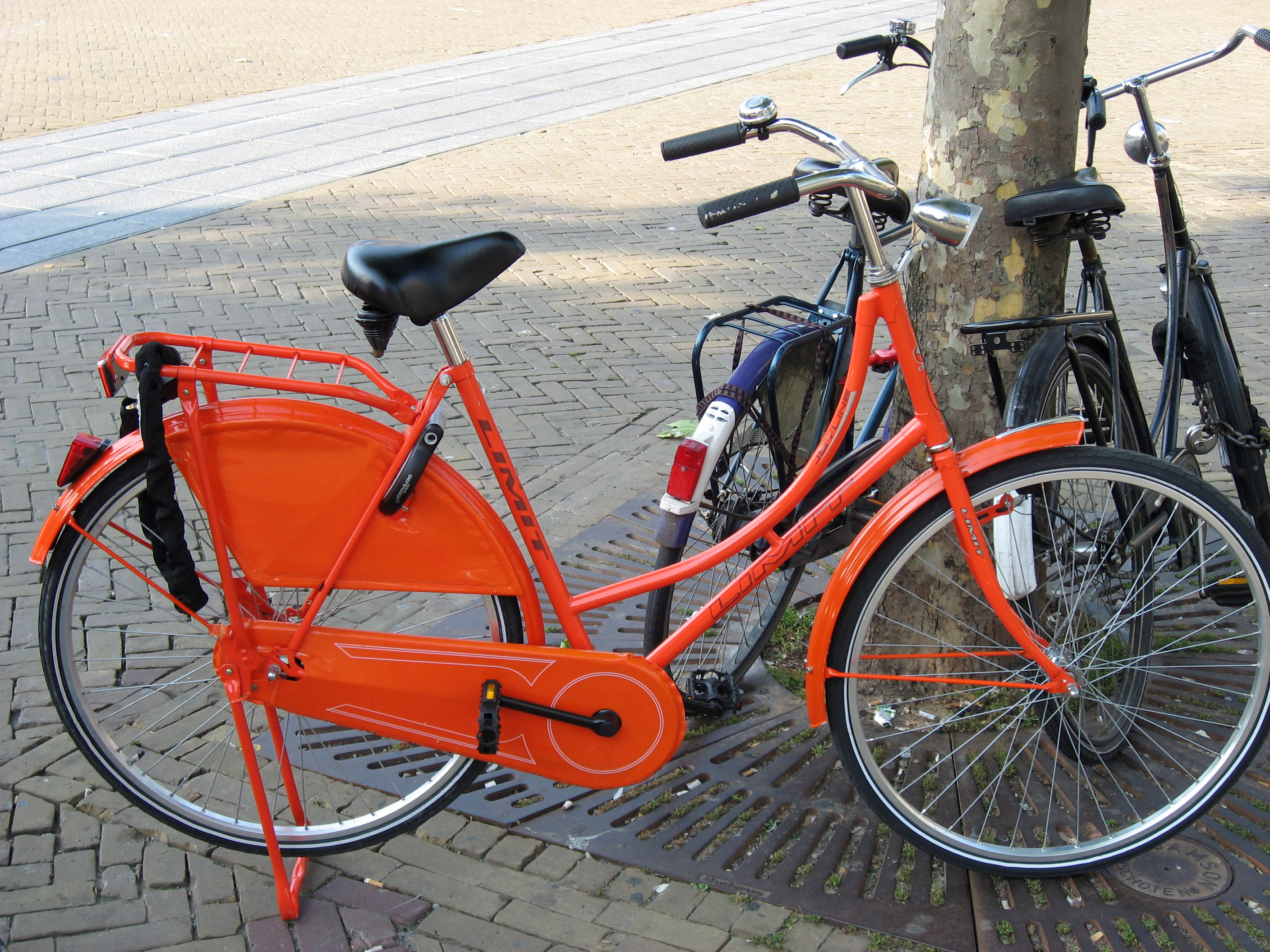
The picture below is annotated in red to show some classic
Amsterdam Bicycle Trends. One I haven't pointed out before is marked "A",
and is a type of bicycle fender that also has covers on the side of the wheel.
This is VERY common, scroll around and look at most other bicycles which have
this same side covered Amsterdam bicycle fender. Next is "B", a type of
bicycle stand that rotates under the back wheel, also very common in Amsterdam
and is visible in many other pictures on this page. Next is the dynamo
human powered bicycle head light marked "C" in the picture below. Finally
is "D" the circular bicycle wheel lock or O-lock found on many Amsterdam
bicycles.
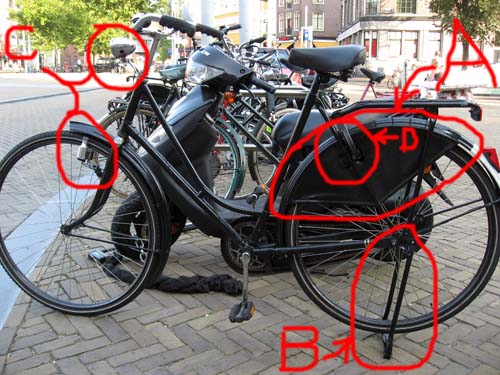
Below shows a picture of one of the massive steel chains that
are standard for Amsterdam bicycle locks.
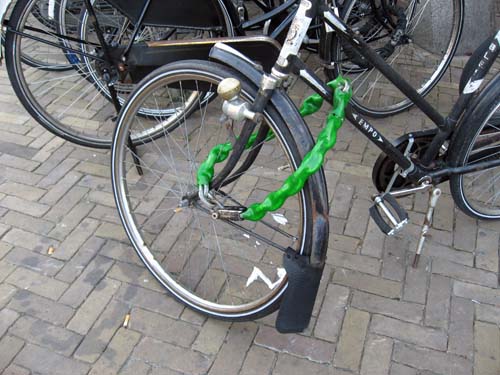
Intermixed big locks on bicycles in Amsterdam.
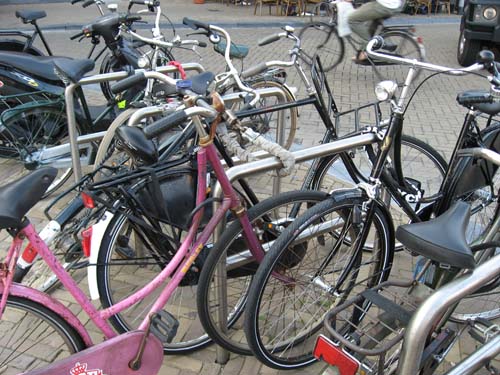
Notice the red circles on the picture below. That's a
Kryptonite style U-lock, plus a circular O-lock rear wheel lock, all to lock up
this bicycle, which I estimate to be worth less than $10 if you tried to sell
it.
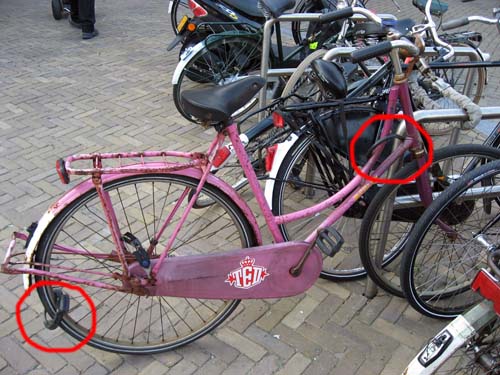
A honking big Amsterdam bicycle chain secures this rear wheel.
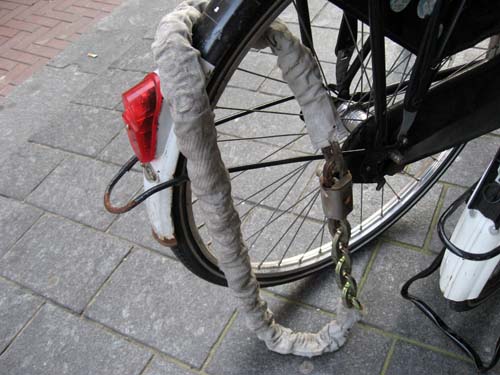
The picture below shows how Amsterdam bicyclists carry these
gigantic chains when underway. The blonde Amsterdam woman in the picture
below wraps the gigantic chain around the handlebars and lugs it along until her
next stop.
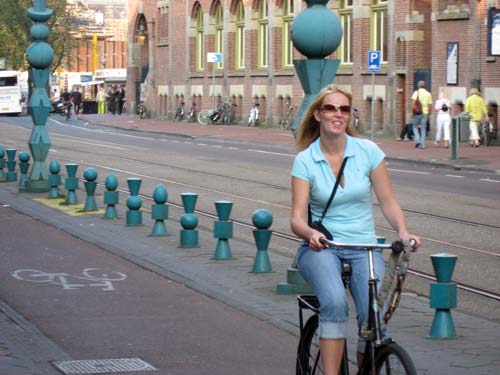
The picture below shows a big thick special high security cable
on the front wheel, and a back wheel circular bicycle lock O-lock rear wheel
bicycle lock thing on the rear wheel, on one flower power printed cheap
multi-color bicycle in Amsterdam.
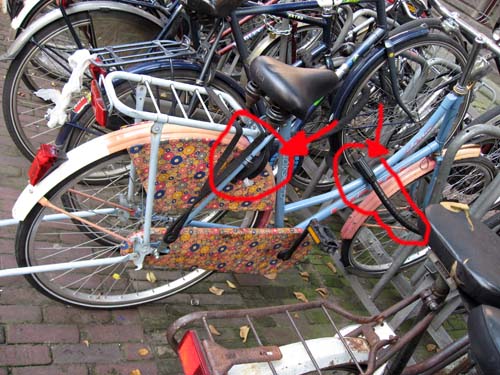
A double wrap on this gigantic huge chain securing this bicycle
in the picture below. And nice padlock too, the padlock alone is worth as
much as the bicycle it is securing here in Amsterdam.
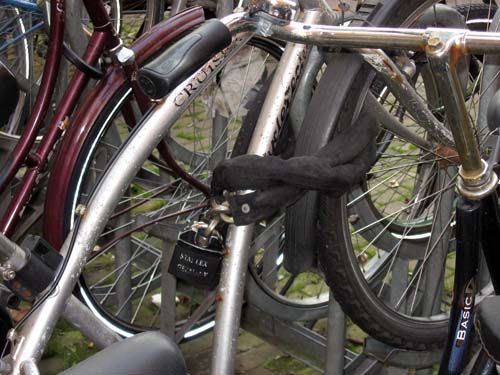
I like the picture below because it shows both a nice hefty Amsterdam bicycle lock chain, plus the dynamo from a human powered bicycle light.
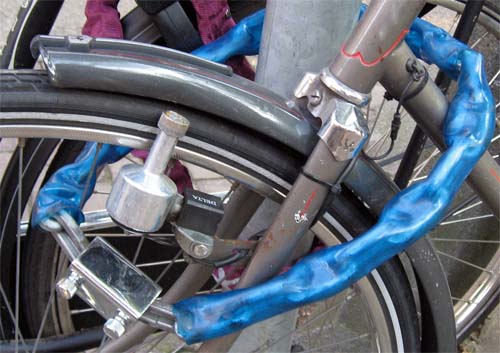
الاشتراك في:
الرسائل (Atom)
